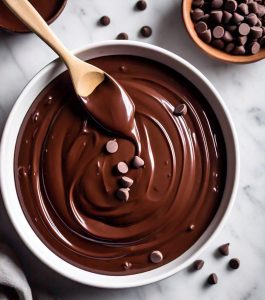Chocolate is a sweet, usually brown food preparation of roasted and ground cacao seeds that come in various forms like solid blocks or in liquid form.
A common query arising among chocolate lovers is whether one can melt it in the microwave.
This article delves into answering that question by discussing everything about chocolate, its types, melting points and the possibility of microwaving it. We will address if you can microwave different types of chocolates and how long to do so without destroying their nutrients and flavors. Additionally, alternative methods to melt chocolate if microwaving is not recommended will be discussed along with tips for precautionary measures during this process. The content also includes FAQs about microwaving chocolates and a final summary.

Jump To:
Is it Possible to Melt Chocolate in the Microwave?
Yes, you can indeed melt chocolate in the microwave. However, it’s crucial to do so with care as overheating can result in a burned and clumpy mess instead of smooth melted chocolate. Using low-power settings and stirring at regular intervals will help achieve desirable results. It’s worth noting that different types of chocolates might require varied melting times.
Check out if you can melt chocolate chips in the microwave.
Facts About Chocolate
Here we will discuss the important things to note about chocolate.
- Nutrients: Chocolate is rich in antioxidants and contains a good amount of soluble fiber. It’s also packed with minerals like iron, magnesium, copper, manganese, potassium, phosphorus, zinc and selenium.
- Theobromine: This compound found in chocolate has a mildly stimulating effect similar to caffeine. The darker the chocolate, the higher its theobromine content.
- Cocoa Content: The cocoa content refers to how much of the product is made from actual cocoa beans. Dark chocolates typically have higher cocoa content than milk or white chocolates.
- Sugar Content: Most commercial chocolates are loaded with sugar which could lead to health issues when consumed excessively. Dark chocolate generally has less sugar compared to other types.
- Milk Solids: Milk solids are present in milk chocolate giving it a creamier texture and lighter color compared to dark chocolates that do not contain any milk solids.
- Fat Content: Chocolates contain fat from cocoa butter. Darker varieties usually have more fat because they have a higher percentage of cocoa beans.
In conclusion, there are many things to consider about melting chocolate in the microwave, especially, its properties like sugar and fat contents that can affect how well it melts.
Now we will discuss some other topics related to microwaving chocolate.
Check out if you can microwave nutella.
How Long Can You Microwave Chocolate?
The length of time you can microwave chocolate depends on the amount and type. Generally, a standard-sized chocolate bar (around 100 grams) should be microwaved for about 60 seconds at a medium power level. The key is to avoid overheating as it may lead to scorching or seizing. For larger quantities, increase the heating time proportionately but always remember to stir every 20-30 seconds.
Does Heating Chocolate in the Microwave Destroy its Nutrients?
Microwaving chocolate does not significantly affect its nutritional value when done correctly. Chocolate, particularly dark variants, contains beneficial nutrients like antioxidants and flavonoids which are fairly heat stable. However, excessively high temperatures could possibly degrade some of these beneficial compounds so moderation in heating is important.
Does Heating Chocolate in the Microwave Affect Flavors?
The process of microwaving can indeed alter the flavor profile of chocolates but this largely depends on how well it’s done. Overheating tends to produce a burnt taste while optimal melting brings out deeper cocoa aroma and creaminess. Therefore, careful control over temperature and timing during microwaving is crucial for retaining flavorful attributes.
In conclusion, we discussed various factors about melting chocolates in the microwave.
Now let’s move on to frequently asked questions that further delve into this subject.

Frequently Asked Questions (FAQs)
In the upcoming sections, we will delve into the most commonly asked questions related to melting chocolate in a microwave.
Can I melt chocolate in the microwave?
Yes, you can melt chocolate in the microwave. However, it is important to heat on low power and stir frequently as microwaving can cause hot spots leading to burned or overheated parts. Use short intervals of about 15-30 seconds for best results and prevent any damage to the flavor and texture of your chocolate.
Does melting chocolate in a microwave affect its texture?
Microwaving doesn’t negatively affect the texture if done properly. Just keep an eye during the heating process because overcooked or scorched chocolate turns grainy ruining its smoothness. Use a lower power setting and shorter time frames for optimal results.
What is the ideal time and temperature for heating chocolate in a microwave?
The ideal time is usually around 1-2 minutes depending on your microwave’s wattage but should be done in steps of 20 seconds each while stirring after every step until completely melted. As far as temperature goes, aim for a warm-to-touch state around 90 degrees Fahrenheit or less.
Is it possible to reheat melted chocolate in a microwave?
Absolutely! You can reheat leftover melted chocolate using a similar method as before—using low power settings with short bursts followed by regular stirring—to ensure even reheating without compromising on its quality and consistency.
Check out if you can melt caramel in the microwave.
This wraps up our FAQs section regarding microwaving chocolates!
Final Word
In conclusion, melting chocolate in a microwave is indeed possible with careful attention paid towards duration, temperature control and frequent stirring. It’s a quick, convenient method saving you time without any significant compromise on texture and quality of the chocolate. Remember to use this information responsibly for optimum results!



